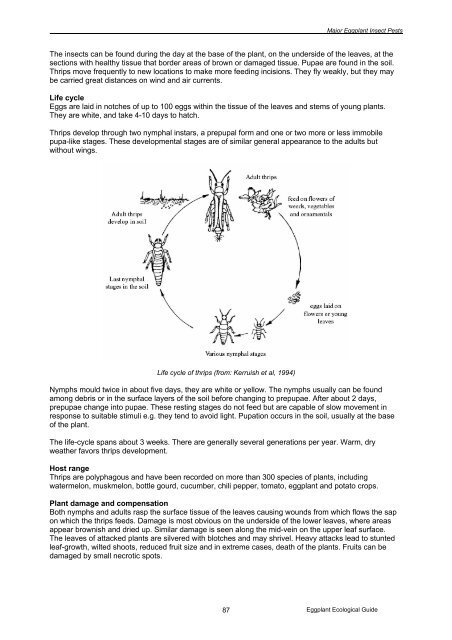__________________________________________________________________________________Major <strong>Eggplant</strong> Insect <strong>Pest</strong>sThe insects can be found during the day at the base of the plant, on the underside of the leaves, at thesections with healthy tissue that border areas of brown or damaged tissue. Pupae are found in the soil.Thrips move frequently to new locations to make more feeding incisions. They fly weakly, but they maybe carried great distances on wind and air currents.Life cycleEggs are laid in notches of up to 100 eggs within the tissue of the leaves and stems of young plants.They are white, and take 4-10 days to hatch.Thrips develop through two nymphal instars, a prepupal form and one or two more or less immobilepupa-like stages. These developmental stages are of similar general appearance to the adults butwithout wings.Life cycle of thrips (from: Kerruish et al, 1994)Nymphs mould twice in about five days, they are white or yellow. The nymphs usually can be foundamong debris or in the surface layers of the soil before changing to prepupae. After about 2 days,prepupae change into pupae. These resting stages do not feed but are capable of slow movement inresponse to suitable stimuli e.g. they tend to avoid light. Pupation occurs in the soil, usually at the baseof the plant.The life-cycle spans about 3 weeks. There are generally several generations per year. Warm, dryweather favors thrips development.Host rangeThrips are polyphagous and have been recorded on more than 300 species of plants, includingwatermelon, muskmelon, bottle gourd, cucumber, chili pepper, tomato, eggplant and potato crops.Plant damage and compensationBoth nymphs and adults rasp the surface tissue of the leaves causing wounds from which flows the sapon which the thrips feeds. Damage is most obvious on the underside of the lower leaves, where areasappear brownish and dried up. Similar damage is seen along the mid-vein on the upper leaf surface.The leaves of attacked plants are silvered with blotches and may shrivel. Heavy attacks lead to stuntedleaf-growth, wilted shoots, reduced fruit size and in extreme cases, death of the plants. Fruits can bedamaged by small necrotic spots.87<strong>Eggplant</strong> Ecological Guide
__________________________________________________________________________________Major <strong>Eggplant</strong> Insect <strong>Pest</strong>sNatural enemies• Predatory mite Amblyseius cucumeris. This predatory mite eats various thrips species; both hatchingeggs and larvae. Predatory mites also eat spider mites, several other mites, honeydew and pollen.Very good results are obtained in various countries with release of this predatory mite for control ofspider mites and thrips. In Indonesia for example, Amblyseius cucumeris was introduced from theNetherlands, where it is commercially available, for testing its effect on Thrips parvispinus on hotpeppers.• Natural enemies of Thrips palmi had not been recorded from Southeast Asia until they werediscovered in Thailand during 1987-88. Among eight species discovered, the larval parasitoidCeranisus menes, a wasp, the larval predator Bilia sp., and Orius sp., both bugs, were evaluated aseffective natural enemies of T. palmi in Thailand. Neither classical biological control of T. palmi norinundative release of its natural enemies is considered necessary for South East Asia because T.palmi is native to this region and should have effective natural enemies in this region. Studies inThailand and Japan support the view that the increase of Thrips palmi is due to the exclusion ofnatural enemies after insecticide application.• Lacewings (Chrysopa sp.) are predators of thrips. The green lacewing, Chrysopa carnea, is the mostcommon species. Because larvae of lacewings are generalist predators, (larvae feed on thrips,whitefly, aphids, jassids, and small caterpillars) they can be used in a wide variety of agriculturalcrops. In various countries, lacewings are commercially available.• There seem to be fungi that attack thrips. Fungal infestation however, requires high humidity andthrips are important mainly in the dry season. The potential for pathogens for the control of thripsseems therefore not very high.Parasitism of thrips on eggplant in ThailandIn a field survey, 40 – 60% parasitism of thrips by Ceranisus menes was found in eggplant gardens,which were not treated with insecticides. In commercial production fields sprayed with insecticides,no parasitism was found. The survey also showed that the thrips population was always higher in thesprayed than in the unsprayed plots (Hirose, in Talekar, 1991).This, at first sight controversial, phenomenon can be explained as follows. Insecticide applicationmay kill part of the thrips population but will seldom eradicate all thrips. Parasitoids are moresensitive to pesticides and usually need more time to build up an effective population. By the time asmall new population of parasitoids is build up, the thrips are already abundant and damage to thecrop may occur.<strong>AN</strong>D, to make it all worse: in fields where thrips were not a problem before, they can become amajor pest after insecticide applications. Again, this is because the natural enemies of thrips arekilled and thrips can expand into damage causing levels.Insecticides used for the control of pests other than thrips in fact contribute to its resurgence….Some scientists say that the increased incidence of Thrips palmi in Southeast Asia could be theresult of increased insecticide applications in some areas of this region for the past 10 years.<strong>Management</strong> and control practicesPrevention activities:• Resistant varieties: Differences in varietal reaction to thrips attack have been recorded in a number ofvegetables, but not in eggplant. The erratic nature of thrips infestation makes screening for host-plantresistance in eggplant difficult. The breeding for resistance of eggplant to other insect pests such asfruit and shoot borer, which in most areas is the most serious insect pest of eggplant, should bestrengthened. Crop varieties resistant to these pests will reduce the need for the use of insecticides.Non-chemical control of other pests will similarly help preventing thrips outbreaks.88<strong>Eggplant</strong> Ecological Guide




![Section 4 [ PDF file, 252 KB] - The Field Alliance](https://img.yumpu.com/51387260/1/158x260/section-4-pdf-file-252-kb-the-field-alliance.jpg?quality=85)











